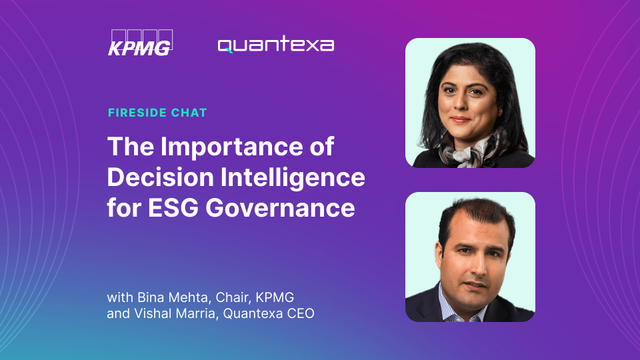Monitoring and Managing ESG Risks with Advanced Analytics
Advanced analytics can improve data quality and facilitate ESG risk management.
Environmental, Social and Governance (ESG) risk is demanding more and more attention from leaders and C-suites in virtually every industry. It is something that can no longer be ignored or denied.
ESG risks represent a complex and multi-dimensional set of challenges. The pressures to address ESG and associated lending and risk management analytics are coming from many sources, including regulators and investors.
Recent events have reinforced the urgency of addressing ESG risks and promise to bring more clarity to the process. These include:
In November, the European Central Bank (ECB) released its first-ever, large-scale assessment into how well-prepared Euro Zone banks are to manage climate and environmental risks. The ECB concluded that “no supervised bank (of 112 total) is close to meeting all ECB expectations on climate and environmental risks.” Less than 20% of the ECB-regulated banks have developed key risk indicators to monitor. The ECB is planning to administer Climate Risk stress tests for all its supervised banks in 2022.
Also in November, the formation of a new worldwide organization was announced with the mission of defining standards for how companies should disclose their risks, plans and progress on sustainability issues with a global baseline. The group, the International Sustainability Standards Board (ISSB), will begin operating this year.
How FSIs can reach their ESG goals
There are two main categories of climate-related risks: Physical risks, which are defined as financial losses from weather-related events; and transitional risks, which may be incurred as a result of the transition from a high-carbon to a low-carbon economy.
One of the most daunting challenges is how to measure, monitor and mitigate ESG risks. The creation of the ISSB is designed to help address that. ESG risks are not only a function of a company’s own physical assets, location, and industry sector, but also the risks that affect each individual company’s supply chains: (Do they meet the ESG Risk score?, do they have a sustainability score?), customer base (what industries are they in?, who are the directors within the company?, is their governance structure transparent?), partners and strategic allies, government policies and other factors.
Banks and insurance companies need to embed the above ESG evaluation into their lending and underwriting policies, and they will have to dig deeper than just relying on the words and public statements of their customers and potential customers regarding ESG criteria being met. They will need to understand their customers’ progress and performance in meeting ESG goals and conduct dynamic behavioral analytics and scenario analysis – since those will impact the banks’ own ability to achieve publicly stated ESG goals.
Financial institutions are creating strategies and goals to achieve a minimum of 50% of new green lending by 2030. These aggressive targets need infrastructure, automation and connectivity to achieve success. To achieve this, institutions are procuring data new platforms where users can gather and analyze ESG data from operations as the value chain.
A strategic approach will require risk governance functions to model and evaluate a wide range of “what if” scenarios regarding ESG risks. Conducting the climate change stress tests in the longer term should relate to banks’ existing risk and lending data/models, linking the limits, risk appetite and concentrations to assess capital and ESG strategy impact.
Improving data quality, traceability and accessibility
Monitoring, reporting and delivering on ESG KPIs (Key Performance Indicators) takes quality (and volume) data and insight. The critical challenge is not so much about what or how much to report on, but rather to ensure the accuracy of what is reported. With investors and customers demanding more transparency around ESG, it is best to gather insights from a range of initiatives and use it to improve data quality, accessibility and traceability.
To do this, organizations must:
Move away from spreadsheets to automated data collection by leveraging advanced technologies
Establish a data platform to gather and analyze ESG data from operations as the value chain
Leverage ESG ratings and research data to learn what investors know, improve ESG scores and benchmark against peers.
Managing ESG risk with advanced analytics
Advanced analytic tools, designed with these challenges in mind, give financial services the ability to simplify the complexity that comes with analyzing and connecting unstructured and large volume of ESG data points, and conduct a search of unstructured data automatically and within moments. Similarly, network generation capabilities enable analysts and risk governance to identify risk factors in the associations and links between companies and individuals – linkages that would otherwise be hidden or difficult to find.
Improving scores with ESG data will enable organizations to:
Deliver a set of analytical, reporting and business application tools that can provide the necessary hindsight, insight and foresight.
Empower business units to measure carbon footprint, supply chain optimization and green revenue in real time.
The future of ESG risk analysis
We can expect significantly more time and effort to be devoted to this issue in C-suites and board meetings around the world than ever before. Many companies will see ESG risk disclosures and climate risk stress testing as a strategic opportunity which can use to excel, while others will address the issues reluctantly, motivated by concerns about falling behind peers or being called out by regulators or investor groups.
The companies that are most successful in meeting these ESG challenges are likely to be those that excel in applying analytical tools, AI and big data.


